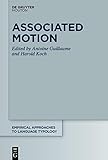Associated Motion / ed. by Antoine Guillaume, Harold Koch.
Material type: TextSeries: Empirical Approaches to Language Typology [EALT] ; 64Publisher: Berlin ; Boston : De Gruyter Mouton, [2021]Copyright date: ©2021Description: 1 online resource (VII, 923 p.)Content type:
TextSeries: Empirical Approaches to Language Typology [EALT] ; 64Publisher: Berlin ; Boston : De Gruyter Mouton, [2021]Copyright date: ©2021Description: 1 online resource (VII, 923 p.)Content type: - 9783110692006
- 9783110692129
- 9783110692099
- online - DeGruyter
- Issued also in print.
| Item type | Current library | Call number | URL | Status | Notes | Barcode | |
|---|---|---|---|---|---|---|---|
 eBook
eBook
|
Biblioteca "Angelicum" Pont. Univ. S.Tommaso d'Aquino Nuvola online | online - DeGruyter (Browse shelf(Opens below)) | Online access | Not for loan (Accesso limitato) | Accesso per gli utenti autorizzati / Access for authorized users | (dgr)9783110692099 |
Frontmatter -- Contents -- Part I: Perspectives and general issues -- 1 Introduction: associated motion as a grammatical category in linguistic typology -- 2 A cross-linguistic survey of Associated Motion and Directionals -- 3 Serial verb constructions and motion semantics -- 4 Associated motion and directionals: where they overlap -- 5 Deictic directionality as associated motion: motion, complex events and event integration in African languages -- 6 A visual stimulus for eliciting associated motion -- Part II: Australia and South Pacific -- 7 Associated motion in the Pama-Nyungan languages of Australia -- 8 Mudburra associated motion in an areal perspective -- 9 “Now the story’s turning around”: Associated motion and directionality in Ende, a language of Papua New Guinea -- 10 Preverbal directionals as markers of associated motion in Paluai (Austronesian; Oceanic) -- Part III: The Americas -- 11 Associated motion in Chácobo (Pano) in typological perspective -- 12 Pilagá directionals and the typology of associated motion -- 13 Associated motion in North America (including Mexico and Central America) -- 14 Associated motion in the Otomi family -- Part IV: Africa -- 15 Associated motion in Bantu languages -- 16 Associated motion and deictic directional in Atlantic languages -- 17 Ventive, associated motion and aspect in Jóola Fóoñi (Atlantic) -- 18 The extension of associated motion to direction, aspect and argument structure in Nilotic languages -- 19 The ‘along’–deictic-directional verb suffix complex in Kupsapiny -- 20 At the intersection of associated motion, direction and exchoative aspect in the Koman languages -- Part V: Asia -- 21 Associated motion in Sino-Tibetan, with a focus on Gyalrongic and Kiranti -- 22 Associated motion in Tungusic languages: a case of mixed argument structure -- Subject Index -- Language Index -- Name Index
restricted access online access with authorization star
http://purl.org/coar/access_right/c_16ec
This volume is the first book-length presentation of the grammatical category of Associated Motion. It provides a framework for understanding a grammatical phenomenon which, though present in many languages, has gone unrecognized until recently. Previously known primarily from languages of Australia and South America, grammatical AM marking has now been identified in languages from most parts of the world (except Europe) and is becoming an important topic in linguistic typology. The chapters provide a thorough introduction to the subject, discussion of the relation between AM and related grammatical concepts, detailed descriptions of AM in a wide range of the world’s languages, and surveys of AM in particular language families and areas.
Issued also in print.
Mode of access: Internet via World Wide Web.
In English.
Description based on online resource; title from PDF title page (publisher's Web site, viewed 25. Jun 2024)


